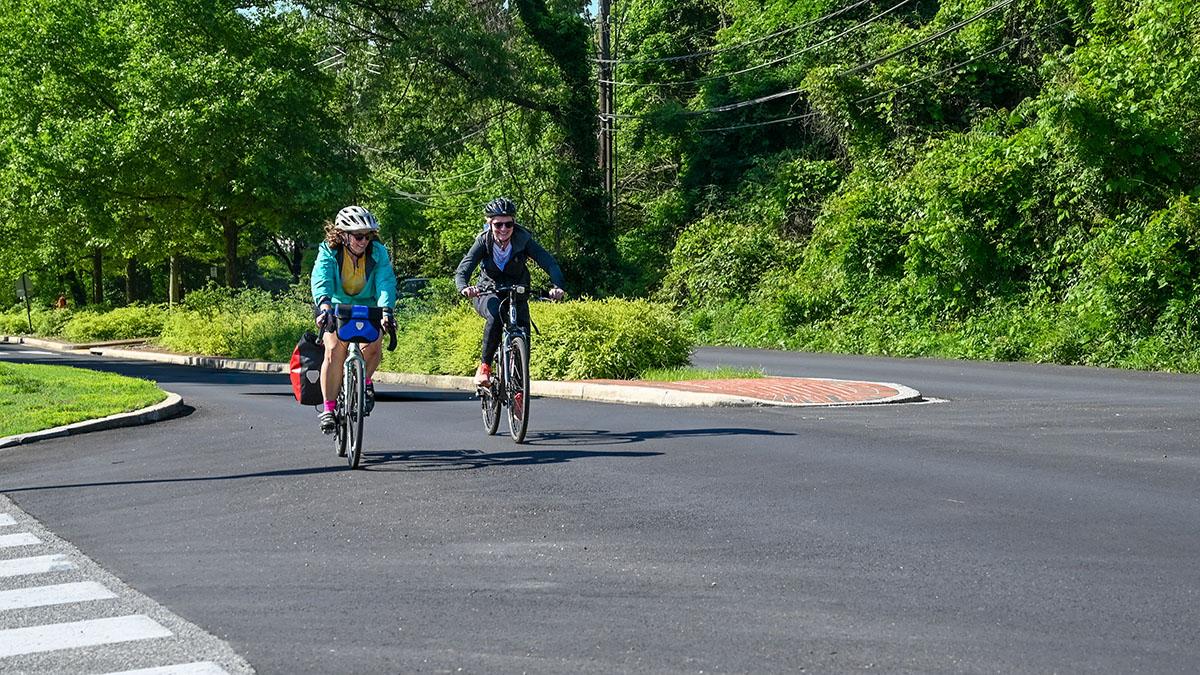The story originally appeared in Maryland Today.
Anyone who’s experienced the off-ramp from the Beltway to Baltimore Avenue on a typical Wednesday morning (and the tangle of roadwork that follows en route to campus) has earned their stripes in the battle to get to work on time.
But road warriors, consider this alternative: the bicycle. I did last month, during National Bike-to-Work Week, traveling 11.5 miles from Capitol Hill in Washington, D.C. to College Park, Md., with Kate Howell, director of the University of Maryland’s National Center for Smart Growth. For one blissful morning I traded views of weary colleagues sucking down coffee in a slow-moving procession for glimpses of rowers on the Anacostia, forested trails and warm smiles from fellow cyclists.
Was I road-ready for this trek? Not exactly. A hiatus from exercise, lack of decent wheels (I borrowed my teenage daughter’s bike) and a less-than-basic understanding of road rules worried me. But Howell, an urban planner who joined UMD last summer, was happy to be my guide.
Howell, who worked in housing and community development in the Baltimore-Washington region for nearly two decades, has logged many thousands of miles on a bike. Last November she wrote a travel diary of her winter commuting adventures for Greater Greater Washington. The self-proclaimed “bike junkie”—she owns four traditional bikes and one e-bike—finally sold her Honda Fit last year.
“I didn’t ever want to go back to that,” she said. “I haven’t been a commuter in a car since 2007.”
During that time, she has seen the region’s biking landscape evolve dramatically, with more bike lanes and infrastructure making the mode safer and more accessible. An influx of bike source apps, rebate programs for e-bikes and city bike maps have made it easier than ever for driving to take a backseat.
“If you want to get people out of their cars, you need to make them feel comfortable on the road,” she said. “I’m seeing a real concerted effort in this area. And for people who work less than five miles from their house, it’s worth giving it a try.”
UMD, said Howell, does a good job encouraging that mode switch. The Campus Bikeways Program feasibility study, which included some initial design work, wrapped this spring; the Department of Transportation Services (DOTS) will lay its first bike lanes this summer, adding a buffered cycle track along Paint Branch Drive between Terrapin Trail and Regents Drive. A second bike lane through the center of Lot 1 will be constructed in 2025.
An accident reporting map, built by UMD urban planning students for the city as part of the Partnership for Action Learning in Sustainability program, allows riders to self-report accidents or near-misses, helping UMD and College Park leadership identify target areas for interventions. UMD’s Bike Incentives Program offers students, faculty and staff a complimentary, secure a spot to stash a bike, take a shower before classes, and even snag free parking permits for rainy days. For the road-wary, DOTS will even accompany new riders on their first trips.
“It’s often a faster way to get to campus, and the adoption of e-bikes is helping people do longer commutes,” said Marta Woldu, DOTS’ assistant director of sustainability initiatives. “If there was ever a time to hop on a bike, it’s now.”
Particularly if you have a daily ride like Howell’s. Sure, there were a few hills, but her commuting pals on the Anacostia Tributary Trail include red-winged blackbirds, juvenile eagles, deer, foxes and wild turkeys. As we rode through the shady neighborhood streets of Riverdale just a mile from campus, I considered a stop for pastries at Manifest Bakery. (Surely, we earned it after 40 minutes of pedaling.)
For Howell, a bike commute is more than a sustainable way to get to work or a replacement for a trip to the gym. The scenery, movement and time to think provide both mental prep for the day ahead and a literal vehicle for unwinding on the ride home.
“It clears my head, especially at the end of the day,” she said, as we took in the magnificent view of Kenilworth Park at 15 mph. “Even after a rough day, the reward you get is this.”
With the academic year in the rear-view mirror, fewer people on the road and more flexibility in work schedules, now is a great time to consider changing up your commute. Here are five tips from Kate Howell, director of UMD’s National Center for Smart Growth, for getting started:
Just get out there. Taking the first ride is the hardest part, said Howell. If you’re new to biking, start slowly by riding on nice days before braving hot or rainy weather.
Keep your bike maintained. “The biggest things are making sure the tires are inflated and the chain is lubricated, but also make sure the bike fits,” Howell said. A good rule of thumb: If biking hurts (beyond just muscle soreness), the seat might be too low or the handlebars too far.
Leave work at work (and consider waterproof saddlebags for the rest). Howell doesn’t lug a ton back and forth on her bike, other than what she absolutely needs for the evening.
Plan your route. Google Maps offers bike routes across the region, and most localities have their own online bike map. “If you have questions about what the ride might be like, use Google Street View,” said Howell. Bikes are treated like cars, so when bike lanes aren’t available, use the road and be sure to learn hand signals.
Get involved in advocacy. “Part of the reason folks don't bike is because they feel nervous about the roads,” said Howell. The Washington Area Bicyclist Association, Terps for Bike Lanes and BikeMore are organizations pushing for safe trails across the region.

